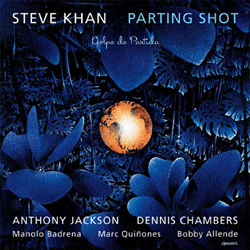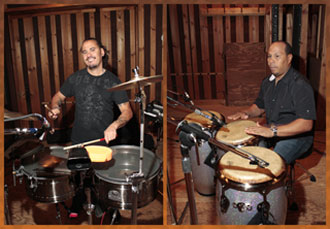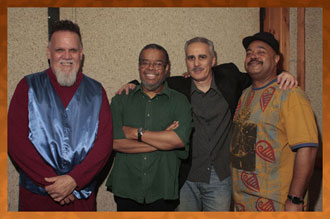

|
Soundclip:
|
| See Steve's Hand-Written Solo
Transcription |
|
Steve Khan's Guitar solo on: "Los Gaiteros"(Steve Khan) During the year 2011, I shared all the lead sheets for the original tunes from "PARTING SHOT"(Tone Center) over at KORNER 2 and, of course, for one of the months, "Los Gaiteros" was featured. Along with my lead sheet, there was an analysis that sought to explain all the details of the composition, the arrangement, the performances by the musicians, and some information pertaining to the origins of the song title.  So, with that in mind, I'm going to try to spare everyone by attempting to not repeat what is already available at that page. Later that year, while the recording was still on its run, I was contacted by guitarist/journalist Simone Salvatore about doing an interview for Italy's "AXE" magazine, one of the top guitar publications there. As we corresponded about the interview, his editor had become excited about the content, and asked if I would do a transcription of one of the solos from the CD for the magazine. As I rarely do transcriptions anymore, and never of anything that I have played, I had nothing laying around the apartment. As this would be a wonderful chance to share more about the recording, I knew that I would have to take advantage of the opportunity. And so, after some thought, hoping to find a solo that was concise, and to the point, I decided that the "Los Gaiteros" solo offered the best of those qualities. And, as I have stated before, this was one of my favorite tunes on the recording. So, with that in mind, I'm going to try to spare everyone by attempting to not repeat what is already available at that page. Later that year, while the recording was still on its run, I was contacted by guitarist/journalist Simone Salvatore about doing an interview for Italy's "AXE" magazine, one of the top guitar publications there. As we corresponded about the interview, his editor had become excited about the content, and asked if I would do a transcription of one of the solos from the CD for the magazine. As I rarely do transcriptions anymore, and never of anything that I have played, I had nothing laying around the apartment. As this would be a wonderful chance to share more about the recording, I knew that I would have to take advantage of the opportunity. And so, after some thought, hoping to find a solo that was concise, and to the point, I decided that the "Los Gaiteros" solo offered the best of those qualities. And, as I have stated before, this was one of my favorite tunes on the recording.The group of musicians for "PARTING SHOT"(Golpe de Partida) remained consistent throughout. The personnel on "Los Gaiteros" included: Anthony Jackson(Contrabass Guitar); Dennis Chambers(Drums); Manolo Badrena(Percussion); Marc Quiñones(Timbal & Maracas); Bobby Allende(Conga); and Rob Mounsey(Synth Orchestration). The fundamental groove or tumbao of the piece, which I decided to write out in 3/4, comes from Anthony's bass. At times, since we recorded it, I have thought to myself that, perhaps, it would have been better to have written it out in 6/4, but, it was a little late to change all that. I guess what can become so confusing for musicians and listeners alike is that the bass tumbao can feel like it is just a simple Salsa tumbao in 4/4, but, it's not that at all! When I listen to what Dennis came-up with as his drum approach, I still marvel at the rhythmic independence that it must take to be playing all these counter-rhythms with each extremity. Of course, his right-hand is banging our quarter-notes on his ride cymbal, a beautiful old Paiste flat ride of mine with rivets. His left hand, plays a huge backbeat on the snare on beat 3 of every 2nd bar. Or, you could say that he plays that backbeat every 6 beats. Then, with his right-foot on the kick drum, he's doubling Anthony's bass part. That, to me, is probably the most miraculous detail. Finally, his left-foot freely opens and closes the hi-hat, as his left-hand occasionally flicks over to hit it in the spaces left between the backbeats. Bobby Allende came-up with a great conga tumbao for the piece, which gives everything an earthy pulse while filling out the time. And finally, Marc Quiñones contributed a pattern using his cha-cha bell to complete the traditional sounds of Latin music. As an overdub, Marc also added the color of the smaller Venezuelan-style maracas, which also contributes greatly to unifying the pulse. As the tune emerged from the first letter [B] section, we cadence to a very lush sounding C7(9/13) chord that hangs over just enough until the solo begins. On the transcription, you will see that I have included that particular chord voicing, as it is played by the guitar. The bass tumbao appears as well.  In general, the feeling created by the entire groove is one that I feel very comfortable playing over, and decided that, the open nature of this C-pedal would give me the harmonic space to go in any direction that my ears would take me. But, on that November day in 2010, I heard something, and just stayed with that direction for the entire solo, which I have now come to view as one 52-bar thought. In hindsight, if we had done another take, I think that I would have played much longer, and explored several other harmonic areas, some of those areas are even suggested within the melodic material that had already appeared. But, I really like the flow of the entire performance very much, and I did not want to tamper with something that had made its point. In general, the feeling created by the entire groove is one that I feel very comfortable playing over, and decided that, the open nature of this C-pedal would give me the harmonic space to go in any direction that my ears would take me. But, on that November day in 2010, I heard something, and just stayed with that direction for the entire solo, which I have now come to view as one 52-bar thought. In hindsight, if we had done another take, I think that I would have played much longer, and explored several other harmonic areas, some of those areas are even suggested within the melodic material that had already appeared. But, I really like the flow of the entire performance very much, and I did not want to tamper with something that had made its point.The opening phrase of the solo is, in its way, connected to the [A2] melody of the tune. And throughout the solo you see the rhythmic connection to that section as well, because of the 16th-note syncopations. Normally, I do not like it when anyone makes a big deal out of the degree of the #4 or b5. In this harmonic area, C7, that would be the note, F#, which you see in the very first phrase. Perhaps because there's nothing there except for Anthony's bass tumbao, which only offers C's and G's, one's ears might not be attuned to any particular chord family. But, the harmonic memory of that long C7(9/13) sonority surely lingers. But, during this particular solo, that same F# appears in virtually every phrase. So, with C-natural as the tonal center, the root, one could say that I was applying the C Lydian b7 scale[C, D, E, F#, G, A, Bb] or G Melodic Minor, as a general point-of-reference. For example, take a look at the long double-time phrase in bars 18-20. Where phrasing is concerned, notice how many of the phrases end with long-short indicated over the notes. This small, but very important, detail is one of the most critical elements in a Jazz musician's vocabulary, and always contributes something felt, more than anything else, to the rhythmic sensibilities of one's fellow players. If you look at the phrases of this particular solo, you might get the sense that they are really phrases that, for some reason, span 6-bars most of the time. In bars 23-26, there is a hint of montuno, which puts to use the basic sound of a C7(9b5) chord: Bb-D-F#. And this small voicing alternates with the upper-3rds of both a D-triad, and a C-triad. The longer phrase from the end of bar 26, begins with a phrasing mannerism always associated with Jazz horn players, here I slurred down from C to A-natural. The line finishes with another double-stop(F#-D), a 6th, which also points to the usage of the D-triad again. As we arrive at bar 30, a couple of great things happen. First, Rob Mounsey's synth orchestration begins. In this case, it's a favorite device of mine, because it only involves playing two notes! Believe it or not, the sustained sounds are only playing a C & Bb.  Yes, a simple major 2nd, that's all. I don't know why, but somehow that very simple sound, played at middle-'C', and below much of the guitar's range, allows me great freedom. At the same time, Dennis Chambers plays one of my favorite drums fills on the entire CD. It's a simple moment, but really brilliant in my view. It happens between bars 32-34, and it's just perfect for the space, and conveys all of Dennis' power, self-confidence, and funk. And that final crash, on beat 3 of bar 34, is just perfection! Sometimes, a simple moment can go unnoticed unless it is pointed out. Beginning in bar 35, this elongated double-time phrase brings in the blues element. For me, no matter what the harmonic material or challenges might be, one should never lose touch with the blues, everything comes from there! The last part of the phrase comes from somewhere between using the A minor pentatonic[A, C, D, E, G] and the blues scale, because of the inclusion of the Eb, a blue note in C7, at the end of the phrase. From bar 39-45, these phrases again rhythmically harken back to the rhythms of the melody in [A2], and operate somewhere between a bluesy feeling, because of the presence of the Bb's, and sounds associated with C7(9b5) again, because of the presence of the F#'s. From the end of bar 45 through to the conclusion of the solo, this double-time phrase is more related to G Dorian[G, A, Bb, C, D, E, F], with a touch of the same blues elements that had just appeared in the phrase from bar 35. From here, the solo section makes the transition to a reprise of letter [B]. Yes, a simple major 2nd, that's all. I don't know why, but somehow that very simple sound, played at middle-'C', and below much of the guitar's range, allows me great freedom. At the same time, Dennis Chambers plays one of my favorite drums fills on the entire CD. It's a simple moment, but really brilliant in my view. It happens between bars 32-34, and it's just perfect for the space, and conveys all of Dennis' power, self-confidence, and funk. And that final crash, on beat 3 of bar 34, is just perfection! Sometimes, a simple moment can go unnoticed unless it is pointed out. Beginning in bar 35, this elongated double-time phrase brings in the blues element. For me, no matter what the harmonic material or challenges might be, one should never lose touch with the blues, everything comes from there! The last part of the phrase comes from somewhere between using the A minor pentatonic[A, C, D, E, G] and the blues scale, because of the inclusion of the Eb, a blue note in C7, at the end of the phrase. From bar 39-45, these phrases again rhythmically harken back to the rhythms of the melody in [A2], and operate somewhere between a bluesy feeling, because of the presence of the Bb's, and sounds associated with C7(9b5) again, because of the presence of the F#'s. From the end of bar 45 through to the conclusion of the solo, this double-time phrase is more related to G Dorian[G, A, Bb, C, D, E, F], with a touch of the same blues elements that had just appeared in the phrase from bar 35. From here, the solo section makes the transition to a reprise of letter [B].When one is playing, improvising over a very open texture like this, it is so important to feel like the space, the emptiness of activity, is more your friend than your enemy. Often times, the tendency is to play in a manner where the space gets filled-up, because, often times as guitarists, we can feel as though, if we remove our left-hand from the instrument, the music is going to stop. Well, that's never the case, because when a phrase has been played, it takes your bandmates time to react to it, if they're going to, and beyond this, the listener needs time too. So, when you breath between phrases, and just let the music speak, there is nothing to really worry about. Generally speaking, though of course the drums, timbal, and conga have pitches, to most ears, in terms of notes, there is just Anthony Jackson's bass and my guitar. So, there's a lot of space right there. This is where the brilliant work of James Farber comes into play again. James is always most modest when assessing the quality of his own work, so it's easy for me to sing his praises here. His choice to use Avatar's EMT 140 Plate reverb is the perfect sonic device to give this percussive production a kind of high-gloss texture without having the music lose any of it toughness. The overall audio presentation is one of great clarity and definition for all of the instruments, and yet everything is so well blended that the end goal - to have everything sound as though we were all playing in one small room together at the same time - is accomplished. Of course, we were playing together at the same time, just with the benefit of some isolation to make for a better audio recording. I am so grateful to James, and all the wonderful musicians, whose instruments, and their touch on them, sound so great that the correct placement of the microphones captures all the details. As we have arrived at the time of the month during April of 2012, I would like to send out a very MERRY UNBIRTHDAY to me, to ME!!! As it is with any and all of the transcriptions that have been offered here at KORNER 1, I am hoping that many of you have found something of interest after reading and listening. Here's wishing everyone a joyous return to Spring. |